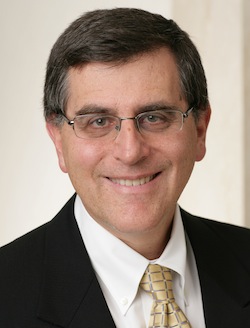Imagine if Spain’s largest banks were unable to roll over their short- term debt, and Spain, as a sovereign issuer, no longer had the resources to recapitalize or nationalize them. Speculation would abound about the euro zone breaking up and whether the euro would survive.
Such an extreme but nevertheless plausible scenario would most likely push down the value of the euro, and the value of euro-tied foreign exchange positions extending beyond a few days would similarly fall.
Most of that exposure flows through large global banks, which are major derivative counterparties. A concentration of trades in a specific direction may pass through just one or two institutions, elevating the risk of a firm-specific meltdown and potentially holding systematic implications.
Similar scenarios can be imagined for over-the-counter derivatives that regulators worldwide are seeking to more closely oversee. Regulators tend to view trading these instruments over trans- parent exchanges as the ideal solution, with clearing through central counter- parties to lessen counterparty risk as the next-best option.
U.S. regulators have all but mandated that OTC derivatives must be cleared, to mitigate counterparty risk and a contagion scenario — except for foreign exchange. The U.S. Department of the Treasury’s FX proposal effectively bifurcates the FX market, requiring FX options and non-deliverable forwards (NDFs) to be cleared while exempting FX swaps and forwards. The Dodd-Frank Wall Street Reform and Consumer Protection Act requires all FX transactions to be cleared, although it gave the Treasury leeway to make some exemptions.
The Treasury was expected to issue its final FX rules earlier this year, and that not happening has prompted some FX market observers to speculate that the agency is rethinking its proposal. It could choose to exempt fewer types of transactions from clearing — a return to the status quo considered highly unlikely as of late August, before the final rule was published — but not impose clearing on NDFs or FX options. Dodd-Frank gave the U.S. Commodity Futures Trading Commission oversight of derivatives in which no asset is delivered, such as NDFs and FX options, and the power to decide whether to exempt from clearing.

Lanny Schwartz, partner at Davis Polk
Many FX market participants have expressed tentative support for the Treasury’s proposal, but splitting the market into transactions that are cleared and others that aren’t remains a cause for concern.
“The definitions around FX products are very confusing, and there’s going to be a lot of people who get it wrong for an extended period of time,” said Lanny Schwartz, a partner at Davis Polk. “There are going to be errors.”
Schwartz noted that trade handlers will have to handle cleared and uncleared products differently, reducing efficiency, and collateral for uncleared transactions won’t be available for their cleared counterparts.
Regulatory Concerns
At a July 10 CFTC meeting, when the agency finalized the definition of a swap, Commissioners Jill Sommers and Bart Chilton expressed concern about the proclivity of Wall Street to tweak transaction structures to receive favorable treatment. Chilton noted, for example, that a firm could call a transaction a forward, which takes actual delivery of an asset and is exempt from clearing, and then find a loophole to avoid taking delivery.
Chilton said that “somebody would call it a forward and then they will not take delivery … they will go ahead and use it as an evasive mechanism. It could be potentially the new Enron loophole, and I think that’s just icky.”
Chilton implied that all FX transactions should be treated the same way, and presumably cleared. Banks and other active FX-market participants’ lukewarm sup- port for the Treasury proposal, on the other hand, appeared to stem more from a realization that two exemptions from clearing is better than none.
T. Rowe Price supported extending the clearing exemption to NDFs. The institutional asset manager acknowledged in a comment letter that it is not within Treasury’s power to exempt NDFs, but it argued that requiring clearing for FX forwards but not for NDFs could cause “disruptive inconsistencies” and “heighten operational and system risks.”
A T. Rowe Price spokesperson referred a follow-up query to a recent Investment Company Institute comment letter.
The split “would result in operational difficulties for market participants when assessing their swaps activity for purposes of certain CFTC rules,” the ICI stated, adding, “it also could allow for potential arbitrage between the two types of FX forwards” as well as increased fragmentation in the currency markets.
An exemption for NDFs appears unlikely to be implemented anytime soon, and exempting FX options may be even further off, especially if Democrats do well in the November election. It is possible that the Treasury could move in the opposite direction and require more or all FX transactions to be cleared, though that appears unlikely given that clearers for FX forwards and swaps do not exist and there is no indication such facilities are in the works.
The Treasury appears to have sought a middle ground between the Dodd-Frank push to apply clearing across all OTC products, and the preference of many FX market participants for the status quo. The no-change crowd argues that besides the operational burdens imposed by clearing, it concentrates risk at a few central counterparty (CCPs) rather than spreading it across numerous market participants. In addition, they say the short-term nature of most FX transactions generates settlement risk but little credit risk.
Trade associations such as the American Bankers Association and the Securities Industry and Financial Markets Association note a Bank of International Settlements survey that showed 68% of X forwards and swaps mature within a week, another 13.5% mature between a week and a month, and 16.2% mature between one and six months.
However, according to Foreign Exchange Committee data, more than half the monthly volume for new FX forward contracts mature in more than a month, as do 30% of FX swaps. Both FX swaps and forwards have notional monthly volumes of about $1.4 trillion. Time-to-maturity may be a red herring for the FX market. The asset class tends to be volatile even without major market-moving events, and much can happen within a month, said Darrell Duffie, a professor at Stanford University’s Graduate School of Business.
Duffie noted the hypothetical scenario involving Spanish banks could play out in weeks or even days. “Any FX positions with maturities beyond several days could suddenly be down 20% or more,” he said.
BIG NUMBERS
Gross credit exposures, FX market- wide, have been around $700 billion, most highly concentrated in the Euro-dollar currency pair, according to Duffie. “Suddenly, tens of billions of dollars worth of Euros may disappear, possibly destabilizing some important financial institutions,” he said.
Such a hypothetical scenario is not a far cry from what actually occurred during the financial crisis of a few years back. A BIS working paper published in 2009 details how volatility in FX swaps began across several G10 currency pairs around the mid-2007. By September, the FX swap-implied spread between dollar rate and dollar Libor widened to more than 40 basis points.
The unfolding financial crisis prompted many financial institutions to convert Euros to dollars through FX swaps, resulting in a shortage of dollars and a one-sided market. The BIS noted that “concerns over the counterparty risk of financial institutions expanded well beyond those headquartered in Europe, and the dollar-liquidity problem for European institutions deepened into a phenomenon of global dollar shortage.” In the fall of 2008, foreign exchange was one of several liquidity factors that imperiled financial institutions’ credit worthiness. In October, restrictions on swap lines provided by the Bank of Japan and other major central banks were lifted, giving central banks and eligible counterparties unlimited access to U.S. dollar funding in response to dire market conditions.
Proponents of clearing all FX argue that the lack of transparency and counter- party risk inherent in the bilateral relationships between counterparties in FX and other OTC markets led to the financial system freezing up, and more financial institutions may have imploded had regulators not stepped in. The increased transparency and credit strength of central counterparties, they say, would all but eliminate those concerns.
In Duffie’s view, the solution may be less of a traditional clearing facility, which assumes the role (and risk) of buyer and seller in transactions in order to reconcile them, and more of a facility that imposes margin on counterparties. “It would hold margin delivered to it by the counterparty that’s out of the money, and hold it to give to the party that’s in the money, should something happen,” Duffie said.
Duffie acknowledged market participants generally would not support his idea. “There’s almost no one who will stand up and say they want to bear this cost” without a direct benefit, he said, adding some regulators see merit in the proposal.
Tacking on costs may be problematic, given the highly liquid FX market’s tight spreads, as well as a broader, ongoing market malaise. Schwartz of Davis Polk noted that there are direct costs such as fees and clearing firms’ collateral requirements, and there are indirect costs associated with setting up documentation and new arrangements with brokers, and hiring more staff.
Nevertheless, markets do adjust, Schwartz said. Costs “will likely be greater in the short run and level out in the long run,” he said. Perhaps a bigger concern is that the clearing paradigm, whether for just NDFs and FX options or for all four types of FX products, relies on futures com- mission merchants as transaction guarantors. The perceived safety of FCMs has been called into question over the past year in the wake of high-profile implosions of MF Global and Peregrine Capital Management.
UP TO TASK?

Steven Lofchie, partner at Cadwalader Wickersham & Taft and co-chairman of its financial services department
“FCMs are not big entities,” said Steven Lofchie, partner at Cadwalader Wickersham & Taft and co-chairman of its financial services department. “How are they going to be financially able to guaranty the credit risk of a Citibank’s or a SocGen’s FX trades? It’s like a mouse guaranteeing the performance of an elephant.”
David Frenk, research director at non- profit Better Markets, which advocates for financial reform, counters that “FCMs collect initial and variation mar- gin, so at any given moment they have adequate capital to cover a default by any one party.”
According to Lofchie, however, any margin collected by the FCM’s capital could be quickly wiped out in the window after a large customer fails but before that customer closes out positions. “Thus, if I am a solvent customer of the failed FCM, I am going to be at best severely inconvenienced,” Lofchie said. “This has nothing to do with whether the clearinghouse fails.”
Frenk said measures instituted by Dodd-Frank make a clearinghouse failure highly unlikely. He noted that CFTC rules require the clearinghouse’s largest members to share the cost if an FCM doesn’t have sufficient margin and capi- tal at its disposal to cover a floundering customer. Plus, he said CFTC rules require clearinghouses to have enough capital to withstand the default of its two largest members.Craig Pirrong, a professor of finance at the University of Houston’s Bauer College of Business, added some perspective to the question of whether FCMs are up to the guarantor role. Pirrong said mar- gins are chosen to cover 99% of all price moves, so there’s always a 1% chance margins will be insufficient, and there’s always the possibility a CCP’s model will underestimate the likelihood of big price moves.

Craig Pirrong, finance professor at the University of Houston’s Bauer College of Business
“The outright failure of a CCP is an unlikely event. But it could happen.”
If margins fail, the FCM must cover any deficits resulting from a defaulting customer, and if the FCM defaults because it has insufficient capital to cover the deficit, “the allocation of the remain- ing loss depends on segregation” of customer assets, Pirrong said. He explained that the existing futures model allows the CCP to access the margins of non- defaulting customers to cover the deficit in the defaulting FCM’s omnibus customer margin account, putting non- defaulting customers at risk.
With the asset-segregation model imposed under Dodd-Frank, and alter- natives regulators considering following the recent FCM implosions, CCPs can no longer use non-defaulting customers’ monies to cover the defaulting custom- ers’ deficit.
If the FCM has insufficient funds to cover the default, then the CCP may commit its own capital, and it can also access a pre-established default fund managed by the CCP to cover any remaining loss, thus mutualizing the loss among other FCMs. If that fund is exhausted, CCPs can require FCMs to replenish the fund.
“Only if all these resources are exhausted will the CCP itself go into default,” Pirrong said. He noted that two clearinghouses, operated by CME Group and The Options Clearing Corp., would likely have defaulted in October 1987, after the stock market crash, had the Federal Reserve not stepped in to fund their FCM members at risk of defaulting. Added the finance professor, “the outright failure of a CCP is an unlikely event. But it could happen.”




